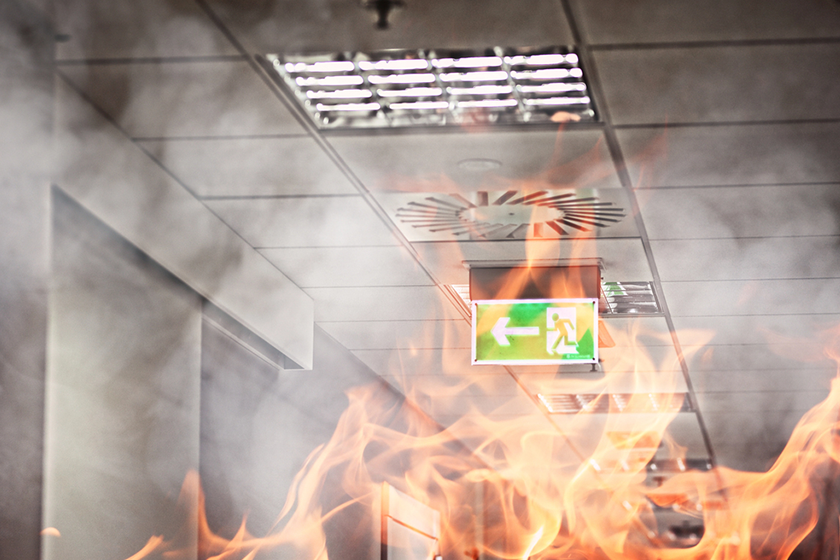10 Fire Hazards In The Workplace And How To Address Them

Fire hazards in the workplace pose a serious risk to both employees and the business itself. Every year, workplace fires lead to injuries, significant property damage, and financial losses. While no workplace is completely free from fire risk, identifying the most common fire hazards and implementing proper safety measures can drastically reduce the chances of fire.
Preventing fires starts with understanding the types of fire hazards that may be present in your workplace. These risks are found in almost every industry, from electrical systems to improper storage of flammable materials. We’ll cover the key fire hazards in the workplace and practical steps you can take to address each one.
Electrical Hazards
Electrical systems are a major source of fire hazards in many workplaces. Faulty wiring, overloaded circuits, and damaged equipment can easily lead to electrical fires. This type of fire is especially common in offices and industrial settings where many devices and machines are used simultaneously.
How to Address Electrical Hazards:
- Schedule regular inspections of all electrical equipment, outlets, and systems by a qualified electrician.
- Ensure that all electrical wiring and devices meet current safety codes and standards.
- Avoid overloading power outlets and circuits with too many devices.
- Replace any frayed or damaged electrical cords and avoid using faulty equipment.
- Train employees to use electrical devices properly and safely.
Flammable Materials and Substances
Flammable materials are common in many industries, especially in factories, warehouses, and construction sites. These materials can ignite quickly when exposed to heat, open flames, or even static electricity. Flammable liquids, gases, and chemicals pose an even greater risk if they are not stored or handled properly.
How to Address Flammable Material Hazards:
- Store flammable liquids, gases, and chemicals in designated areas that are well-ventilated and away from heat sources.
- Use containers designed for flammable materials, ensuring they are tightly sealed when not in use.
- Keep these materials away from sparks, open flames, or any other potential ignition sources.
- Post clear warning signs around storage areas to indicate the presence of flammable materials.
- Train employees on the proper handling, storage, and disposal of hazardous substances.
Improper Use of Heating Equipment
Many workplaces rely on heating equipment, such as space heaters, boilers, or furnaces, to keep the work environment comfortable. However, these heating systems can create significant fire hazards if they are not used properly or maintained regularly.
How to Address Heating Equipment Hazards:
- Perform routine inspections and maintenance on all heating equipment to ensure it operates safely.
- Keep space heaters and other portable heating devices away from flammable materials like paper, curtains, and furniture.
- Ensure that space heaters have built-in safety features, such as automatic shutoff in case of overheating.
- Never leave heating equipment unattended when it is in use.
- Follow the manufacturer’s instructions for safe operation of heating systems.
Poor Housekeeping and Clutter
Clutter and poor housekeeping practices can create significant fire hazards in the workplace. Piles of paper, packaging materials, and other combustible items can act as fuel for a fire. Additionally, clutter can block fire exits, making it difficult for employees to evacuate quickly in case of an emergency.
How to Address Poor Housekeeping Hazards:
- Implement a regular cleaning schedule to ensure that all areas of the workplace remain tidy and free of clutter.
- Properly dispose of paper, cardboard, and other flammable materials in designated waste bins.
- Keep pathways, hallways, and fire exits clear of obstacles at all times.
- Regularly inspect storage areas for any fire hazards, such as excessive clutter or improperly stored materials.
Smoking in or Near the Workplace
While many workplaces have adopted no-smoking policies, smoking remains a significant fire hazard in areas where it is allowed. Cigarettes, if not properly extinguished, can ignite flammable materials, leading to a fire. Smoking near areas where hazardous materials are stored or used poses an even greater risk.
How to Address Smoking Hazards:
- Establish designated outdoor smoking areas away from buildings and any flammable materials.
- Provide metal containers filled with sand for safe disposal of cigarette butts.
- Mark non-smoking areas inside the workplace, especially where flammable substances are stored or used.
- Enforce a strict no-smoking policy in prohibited areas and regularly remind employees of the rules.
Equipment and Machinery Malfunctions
Many industries rely on heavy machinery and equipment to carry out daily operations. Malfunctioning equipment, overheating, or excessive friction can create sparks that ignite nearby flammable materials. Equipment that isn’t regularly maintained can also lead to electrical or mechanical failures, increasing the risk of fire.
How to Address Equipment and Machinery Hazards:
- Schedule regular maintenance and inspections for all machinery and equipment.
- Replace any worn-out or damaged parts as soon as possible to prevent malfunctions.
- Train employees on the proper operation and maintenance of all machinery.
- Ensure that equipment is properly lubricated and ventilated to prevent overheating.
- Keep flammable materials and liquids away from machinery that produces heat or sparks.
Cooking Equipment in Break Rooms
Many workplaces provide break rooms where employees can use kitchen appliances such as microwaves, stoves, and toasters. While these appliances offer convenience, they can also create fire hazards if not used responsibly. Grease fires, electrical malfunctions, and unattended cooking are common causes of fires in workplace kitchens.
How to Address Cooking Appliance Hazards:
- Ensure that all cooking appliances are cleaned regularly to prevent grease buildup.
- Unplug kitchen appliances when they are not in use.
- Never leave cooking equipment unattended while in operation.
- Provide clear instructions for the safe use of kitchen appliances, such as microwaves and stoves.
- Install smoke detectors and fire extinguishers in or near kitchen areas for quick response in case of a fire.
Chemical Hazards
Many industries use hazardous chemicals that can become fire hazards if they are not stored or handled properly. Certain chemicals may be highly flammable or reactive, and they can ignite when exposed to heat, flames, or sparks. Chemical fires can spread quickly and may produce toxic fumes, making them especially dangerous.
How to Address Chemical Hazards:
- Store chemicals in properly labeled containers and ensure they are sealed when not in use.
- Follow all manufacturer guidelines for the safe handling and storage of hazardous chemicals.
- Keep chemicals away from heat sources, open flames, and incompatible substances.
- Train employees on the risks associated with the chemicals they work with and provide them with appropriate safety data sheets (SDS).
- Ensure that personal protective equipment (PPE) is available for employees who handle hazardous chemicals.
Human Error
Human error is one of the leading causes of workplace fires. Simple mistakes, such as leaving equipment running, improperly storing flammable materials, or failing to follow safety protocols, can quickly lead to dangerous situations. Ensuring that employees are properly trained and aware of fire safety procedures is crucial for reducing the risk of fire due to human error.
How to Address Human Error Hazards:
- Provide ongoing fire safety training for all employees, including how to handle equipment safely and how to recognize potential fire hazards.
- Conduct regular fire drills to ensure that everyone knows what to do in the event of a fire.
- Encourage employees to report any potential hazards or unsafe practices immediately.
- Post clear signage throughout the workplace to remind employees of fire safety protocols.
Lack of Fire Safety Equipment
Proper fire safety equipment is one of the most effective ways to prevent fires from spreading. Even a small fire can quickly escalate into a dangerous situation without adequate fire detection, suppression, and firefighting tools. Equipping your workplace with fire safety tools is essential for protecting employees and property.
How to Address Lack of Fire Safety Equipment:
- Install fire alarms and smoke detectors throughout the workplace, and ensure they are tested regularly.
- Place fire extinguishers in easily accessible areas and train employees on their proper use.
- Consider installing an automatic sprinkler system, especially in high-risk areas.
- Make sure that all fire exits are marked and equipped with emergency lighting and panic hardware.
Fire hazards in the workplace are a serious threat, but with the right preventive measures in place, they can be managed effectively. We are here to support your workplace fire safety efforts. Contact us today to learn more about how we can help protect your workplace from fire hazards.
